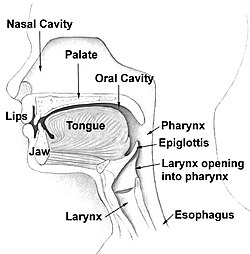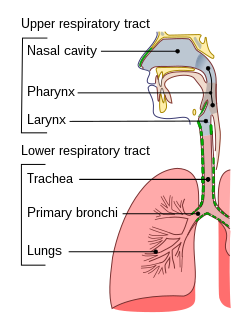Nasal fossae
| Nasal Cavity | |
|---|---|

Head and neck.
|
|

Conducting passages
|
|
| Details | |
| Part of | Nose |
| Identifiers | |
| Latin | cavum nasi; cavitas nasi |
| MeSH | D009296 |
| TA | A06.1.02.001 |
| FMA | 54378 |
|
Anatomical terminology
[]
|
|
The nasal cavity (nasal fossa, or nasal passage) is a large air filled space above and behind the nose in the middle of the face. Each cavity is the continuation of one of the two nostrils.
The term "nasal cavity" can refer to each of the two sides of the nose or to the two sides combined.
The lateral wall of each nasal cavity mainly consists of the maxilla. However, there is a deficiency that is compensated by the perpendicular plate of the palatine bone, the medial pterygoid plate, the labyrinth of ethmoid and the inferior concha. The paranasal sinuses are connected to the nasal cavity through small orifices called ostia. Most of these ostia communicate with the nose through the lateral nasal wall, via a semi-lunar depression in it known as the infundibulum. The infundibulum is bound laterally by a projection known as the uncinate process.
The roof of each nasal cavity is formed in its upper third to one half by the nasal bone and more inferiorly by the junctions of the upper lateral cartilage and nasal septum. Connective tissue and skin cover the bony and cartilaginous components of the dorsum of the nose.
The floor of the nasal cavities, which also form the roof of the mouth, is made up by the bones of the hard palate: the horizontal plate of the palatine bone posteriorly and the palatine process of the maxilla anteriorly. To the front of the nasal cavity is the nasal vestibule and external opening, while the back blends, via the choanae, into the nasopharynx.
The nasal cavity is divided in two by a vertical fin called the nasal septum. On the sides of the nasal cavity are three horizontal outgrowths called nasal conchae (singular "concha") or turbinates. These turbinates disrupt the airflow, directing air toward the olfactory epithelium on the surface of the turbinates and the septum. The vomeronasal organ is located at the back of the septum and has a role in pheromone detection.
...
Wikipedia
